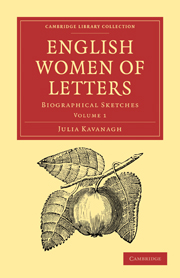Summary
There are lives that read like one long sorrow, and that leave little save sadness and disappointment behind them when they close in death. Such a life was that of Charlotte Smith, full of cares while it lasted, and, once it was over, doomed to fade away from memory. She had great talent—she was one of the best novelists of the day, but the haste and facility with which she wrote, the gloom that overshadowed her life, robbed her of a durable literary fame. As a poetess she is forgotten; as a novelist she but helps to fill the vacant space between Miss Burney and Mrs. Radcliffe. She partakes of the power of these two remarkable women, but only in an inferior degree. She has not the vigour of the one, or the picturesque faculty of the other. Yet she, too, could draw character—witness Mrs. Rayland in the “Old Manor House”—and she, too, could paint the aspect of nature, as many a clear, fresh landscape in the same novel proves. To hold a place in that middle region is great good fortune for the living, but for the dead it is little; and if we attempt to give Charlotte Smith her meed of praise in these pages, it is not without the knowledge that she produced no strong impression, and will leave no lasting trace in the literature of her country.
- Type
- Chapter
- Information
- English Women of LettersBiographical Sketches, pp. 187 - 193Publisher: Cambridge University PressPrint publication year: 2010First published in: 1863

